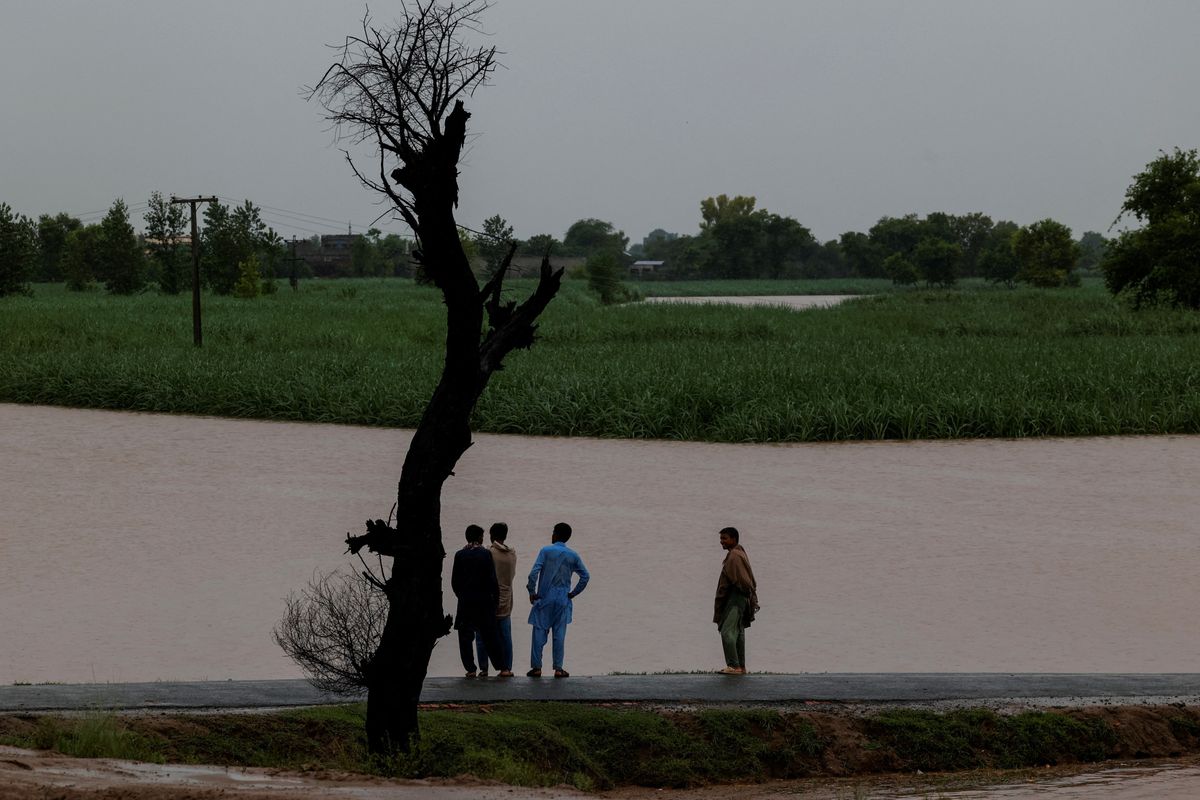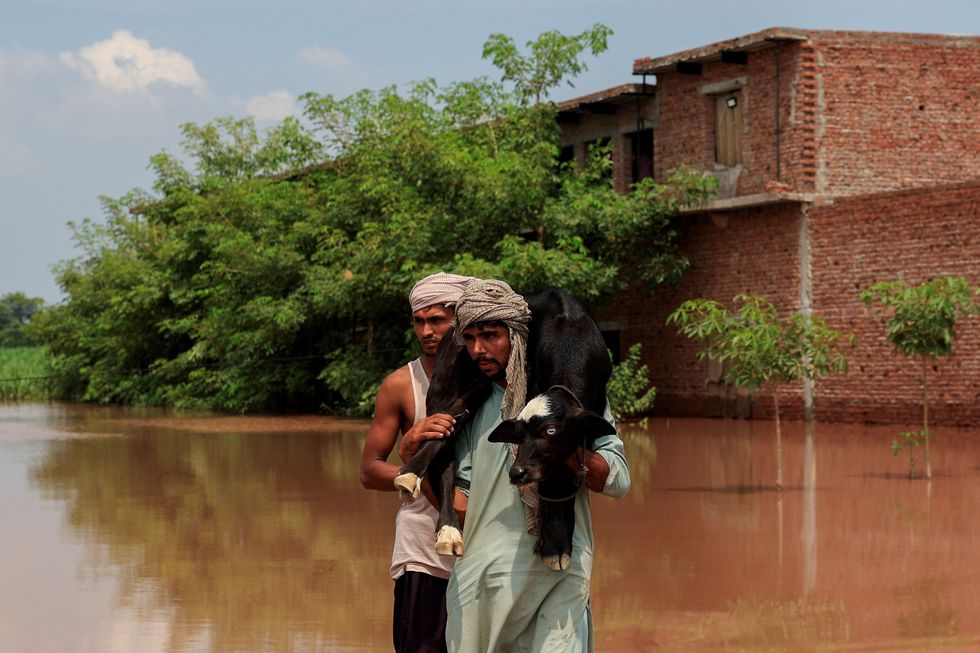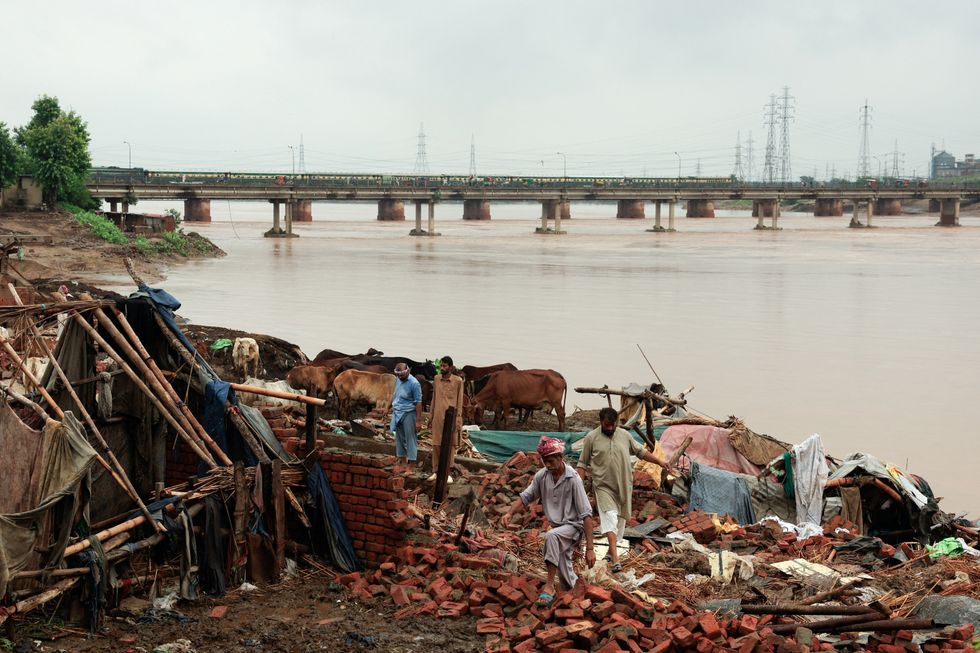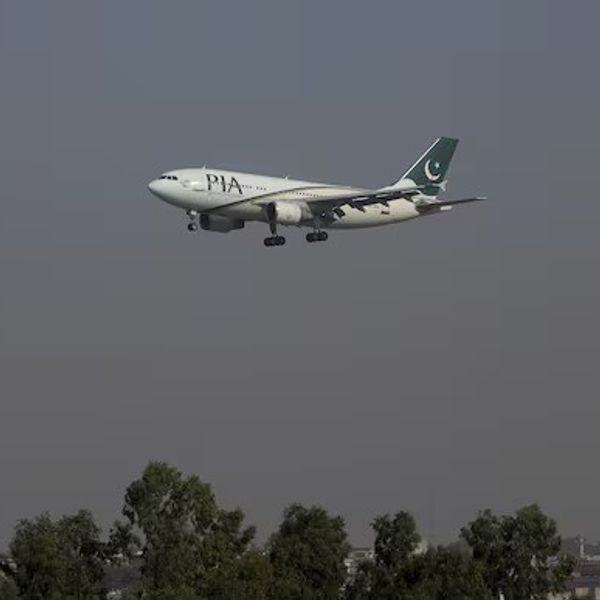Pakistan mulls levee breaches to ease rising river pressure in southern Punjab
Over 400,000 evacuated in Multan district; next 24 hours critical for downstream Sindh

Usama Manj
Producer, Correspondent
Usama Manj is an experienced multimedia journalist with over 8 years in the industry. He began his career at Express News before moving on to Indus News as news producer and then worked for Aik News as a sports producer and anchor.

Residents stand on a higher ground with the flooded field in the background, following monsoon rains and rising water levels of the Chenab River, in Patraki village, Chiniot district, Punjab province, Pakistan, August 30, 2025.
Reuters
Targeted levee breach under review to divert water
Ravi and Chenab flows still rising near Multan
Fresh landslide alerts issued for GB and Kashmir
Monsoon flooding in Pakistan’s Punjab province has forced 1.8 million people from their homes and swamped nearly 4,000 villages after the Sutlej and Chenab rivers overflowed their banks, officials said. Punjab, which sits in eastern Pakistan, is home to more than 100 million people, and serves as the country’s agricultural hub.
Water has spread across districts including Multan, Muzaffargarh, Narowal and Kasur. Downstream in Sindh, authorities are bracing for higher flows as the water moves south, while in the northwest, Khyber Pakhtunkhwa is on alert amid renewed heavy rains that make slopes prone to landslides.
Along the Chenab near Multan, a major city in southern Punjab, conditions worsened Thursday. Deputy Commissioner Waseem Hamid Sindhu, Multan’s top civilian administrator, toured key defenses with a technical committee, visiting the Chenab Bridge and the Shershah Flood Bund, an embankment designed to contain floodwaters, to check for weak points and receive briefings on current conditions.
Engineers are weighing controlled breaches at select sites to steer water away from towns and villages and to shield densely populated neighborhoods and cropland around Multan.
Water levels rise dangerously
The Deputy Commissioner warned that the situation could deteriorate further as floodwaters from the Ravi River are converging with the Chenab. He noted that at Garaywala Chowk, a key monitoring point upstream of Multan, the water level has already exceeded 414 feet and continues to rise.
Speaking to the media, the Deputy Commissioner said that the breaching committee has agreed on the potential breaching of the Head Muhammad Wala Road to alleviate flood pressure. "Our top priority is to protect human lives in the flood-affected areas," he emphasized.

He further stated that a record number of approximately 400,000 citizens have been safely evacuated to secure locations across Multan district. Efforts are also underway to expand the number and capacity of flood relief camps to accommodate the displaced population.
According to the Flood Forecasting Division, over 500,000 cusecs of water are currently flowing through Head Muhammad Wala.
Located upstream of Multan city on the Chenab River, this headworks functions as a critical regulator that manages the distribution of Chenab waters into canals irrigating large parts of southern Punjab.
During flood season, authorities monitor it closely because the volume passing through determines the flood threat downstream to Multan, Muzaffargarh, and areas extending toward Sindh province.
Residents await govt assistance
In Multan city, floodwaters have reached dangerous levels just yards from Shershah Railway Station, inundating nearby neighborhoods.
In New Basti and Basti Ahsan Shah, water levels have risen up to five feet, leaving residents stranded. Thousands of families living near Shershah Railway Station are awaiting government assistance as floodwaters continue to rise rapidly.

Victims expressed their frustration, saying no assistance has reached them despite their desperate situation. "The water is rising fast, and nobody has come to our aid," they lamented.
Rescue operations continue
Meanwhile, Rescue 1122 in Multan said its relief and evacuation operations are continuing without interruption.
The agency reported that rescue teams have safely evacuated stranded residents from various flood-affected areas, including Valot Morr, Basti Sialan Wali, Kot Qasim Bundh, and Head Muhammad Wala. During the operations, a family trapped in floodwaters was also rescued and relocated to safety.

District Emergency Officer Dr. Hussain Mian said that Rescue 1122 remains fully committed to serving the public at all times. He added that teams are deployed around the clock to ensure timely rescues, safe evacuations, and protection of valuables for flood-affected citizens.
"Rescue operations continue throughout the night, and our teams remain on high alert to respond to any emergency situation," he emphasized.
Next 24 hours critical for Sindh
Water levels continued rising at key monitoring points across the region Wednesday evening, with Sukkur Barrage recording dangerous inflows of 330,800 cusecs - significantly more than the 275,850 cusecs flowing downstream, indicating the water is dispersing in Punjab's plains.
At Panjnad, where Punjab's major rivers converge before entering Sindh, rapid increases brought inflows to over 200,500 cusecs with outflows at 186,500 cusecs. Other monitoring points including Guddu, Kotri, and Trimmu barrages recorded flows ranging from 209,000 to 322,000 cusecs.
The Sindh Irrigation Department said flood monitoring across the province continues with relevant institutions prepared for emergency measures. The Provincial Disaster Management Authority said it is closely monitoring the situation, as the next 12 to 24 hours are extremely critical.
Landslide alert issued for northern regions
Meanwhile, the National Disaster Management Authority (NDMA)'s National Emergency Operations Center has issued a landslide alert for Gilgit-Baltistan and Azad Kashmir amid expected heavy rainfall.
Districts in Kashmir, particularly Muzaffarabad, Neelum Valley, Haveli, Bagh, Poonch and Sudhnoti face the threat of severe rains and potential landslides in sensitive areas.
The Karakoram Highway faces increased landslide risks at various points due to expected rains and possible flooding. Key routes potentially affected include Torghar Road (120km), Batgram Road (140km), Shangla Road (160km), Lower Kohistan Road (180km), and Tatta Pani Road (320-360km). Gilgit Road (400-420km), Hunza-Roundu, Skardu and Chitral locations also face landslide threats.
NDMA advised avoiding unnecessary travel in mountainous areas and staying informed through radio, TV and Pak NDMA Disaster Alert systems.
The National Emergency Operations Center remains fully operational 24 hours with NDMA maintaining contact with civil and military institutions, urging residents to follow local administration instructions and contact rescue teams during emergencies.










Comments
See what people are discussing